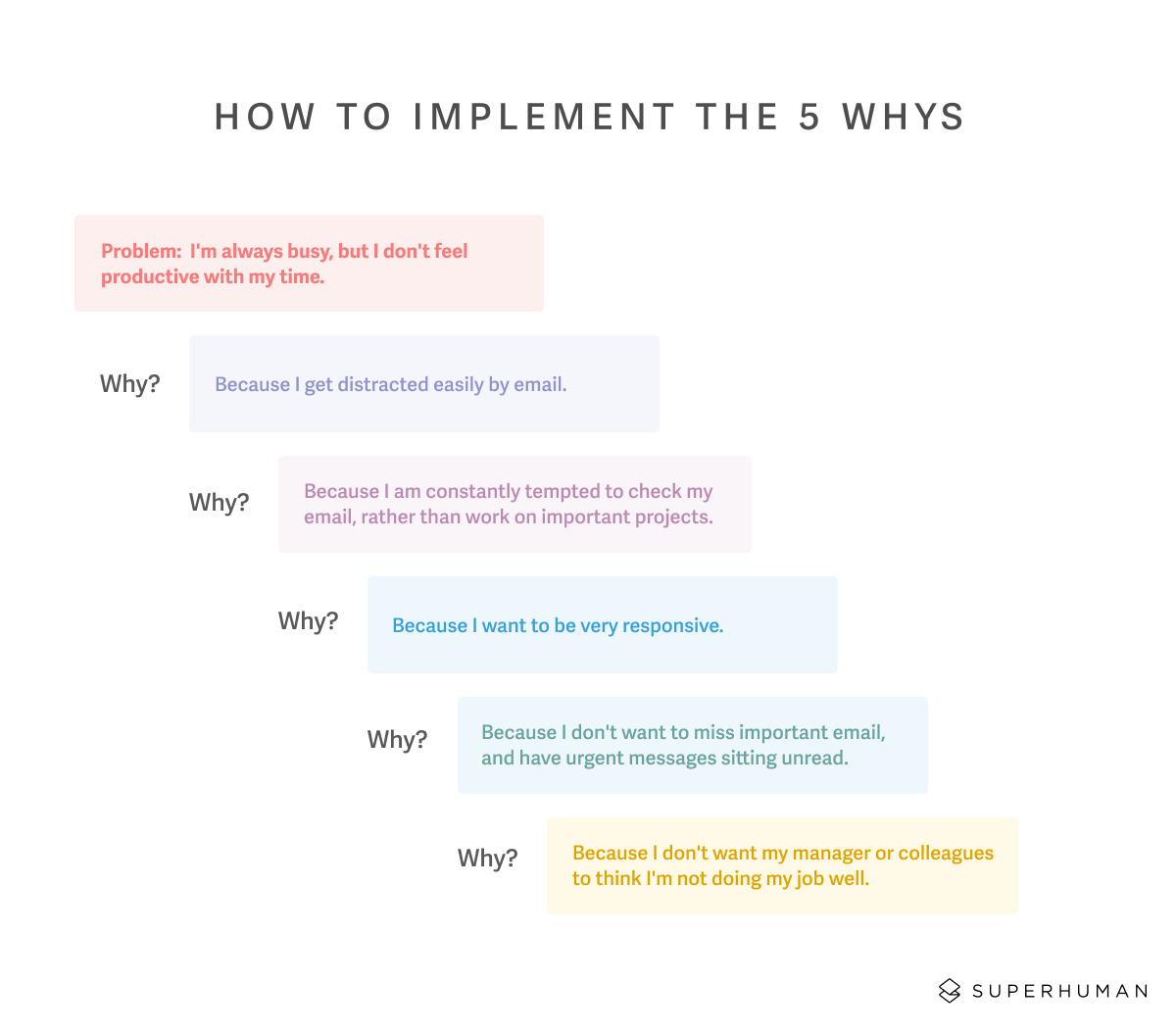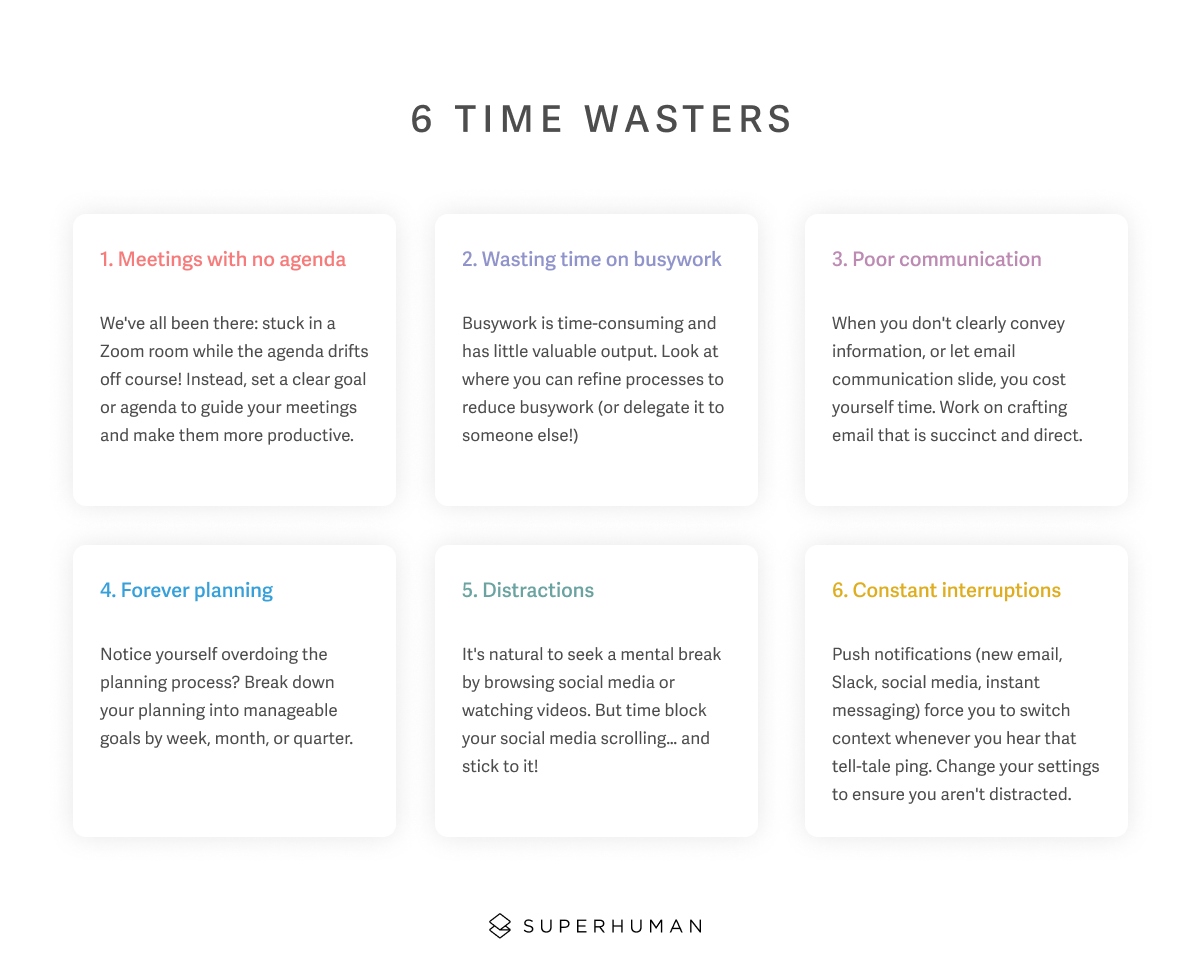
We all strive to be more productive. But does that mean waking up at the crack of dawn for a morning workout, and squeezing in 3 hours on your side-hustle, all before starting work?
Definitely not. At least, not for everyone!
Being productive means being smarter about how you spend your time. Getting more done in less time, and taking on high-impact projects… instead of spending time on unimportant, time-consuming tasks.
Being productive also means you complete tasks — nothing feels better than crossing something off your to-do list! And of course, being productive means you can spend more time doing things you enjoy: like spending time with family and friends, honing a skill, enjoying a hobby, or furthering your career.
When your productivity takes a nosedive, it adds stress and anxiety, as you don't have enough time to accomplish your goals and do what really matters to you. Understanding why your productivity is flailing will help you get back on track.
What is the 5 Whys method and how can it help you?
The 5 Whys technique was developed in the 1930s by Sakichi Toyoda, the founder of the automotive manufacturer Toyota Industries. The idea is simple: ask "why" 5 times, until you get to the root cause of your issue. It's not dissimilar to a kid who exasperates their parents by continually repeating "why"... but the benefits can be transformative!
The goal of the 5 Whys problem-solving method is to reach the root cause of an issue faster — and to drill down to countermeasures.
Solutions solve for symptoms, and they might be short-term fixes; whereas countermeasures propose a preventative response to the problem — ensuring it doesn't recur in the long term.
How to implement the 5 Whys technique to get to the root cause of your productivity issues

Step 1: Define the problem
Your goal is to find the root of your productivity issues.
Your starting point is defining the problem: "I'm always busy, but I don't feel productive with my time."
Step 2: Ask why… 5 times
Rephrase the problem you've just defined as a "Why" question.
WHY #1: Why am I always busy but I don’t feel productive with my time?"
Answer: Because I get distracted easily by email.
WHY #2 Why do I get distracted easily by email?
Answer: Because I am constantly tempted to check my email, rather than work on important projects.
WHY #3 Why am I constantly tempted to check my email, rather than work on important projects?
Answer: Because I want to be very responsive.
WHY #4 Why do I want to be very responsive?
Answer: Because I don't want to miss important email, and have urgent messages sitting unread.
WHY #5 Why don't I want to miss important email, and have urgent messages sitting unread?
Answer: Because I don't want my manager or colleagues to think I'm not doing my job effectively.
Note: You don't have to stop at 5. If you think you can keep going deeper, do.
WHY #6: Why am I worried my manager or colleagues will think I'm not doing my job effectively?
Answer: Because my team has incredibly difficult goals to hit this quarter, and I'm worried we won't hit them.
Step 3: Address the root cause of the issue
Now that you've established the root cause of your low productivity — your worries about hitting the quarter's difficult goals — you can set countermeasures to avoid feeling blocked and distracted by the pressure of these goals. For example:
- Speaking with your manager about setting achievable goals, or revisiting the goals you set at the beginning of the quarter.
- Aligning with your team about communication norms, so you don't feel under pressure to check your email constantly.
Step 4: Tackle secondary factors
Through the 5 Whys process, you can identify the root cause of your productivity issue, as well as secondary factors.
In our example, email isn't the root of the productivity problem, but it's a distracting time waster (more on that later). There are ways to tackle this: email power users use these techniques to reduce email anxiety and get through your email faster. With Superhuman, you'll save 3+ hours every week on email.
Get started with SuperhumanSocial media is another common contributing factor, but there are ways to reduce its impact on your productivity:
- Get motivated to change your habits by measuring your social media time. Your phone offers a weekly review of your screen time usage — or you can use a habit tracker like RescueTime to keep tabs on your desktop usage.
- Turn off notifications and set time blockers on your social media so that you can only access your accounts during certain times, or for a limited amount of time every day (similar to parental blocks). Intentional procrastination can make you even more productive... as long as it's time-boxed!
- Apps like Offtime block distracting apps like social media. Or Flipd can block your phone for a predetermined amount of time, so you cannot access it while you're busy with work or family.
What are "time wasters" and how do you avoid them?
Even with a crystal-clear understanding of the root causes of your productivity problem, time wasters can consume your time and derail your progress.
For example, social media can be a delightful break for your brain... but sometimes you fall down a rabbit hole of memes and cute cat videos, and spend much longer than you intended. We spend an average of 145 minutes (or almost 2.5 hours) per day on social media, and even more hours checking and responding to email.
The result? You're under even more time pressure, and further away from achieving your goals. Here's how to squash 6 common time wasters.
6 time wasters
1. Meetings with no agenda
We've all been there: stuck in a Zoom room while the agenda drifts off course! Instead, set a clear goal or agenda to guide your meetings and make them more productive.
2. Wasting time on busywork
Busywork is time-consuming and has little valuable output. Look at where you can refine processes to reduce busywork (or delegate it to someone else).
3. Poor communication
When you don't clearly convey information, or let email communication slide, you cost yourself time. Write an email that is succinct and direct.
4. Forever planning
Notice yourself overdoing the planning process? Break down your planning into manageable goals by week, month, or quarter.
5. Distractions
It's natural to seek a mental break by browsing social media or watching videos. But time-block your social media scrolling… and stick to it!
6. Constant interruptions
Push notifications (new email, Slack, social media, instant messaging) force you to switch context whenever you hear that tell-tale ping. Change your settings to ensure you aren't distracted.

For many people, communication is right at the top of the list — and that includes email. After all, you need to respond to email from your boss, team, or clients. But sorting through newsletters or sales promotions can kill your productivity.
So how can you remain productive while limiting the time it takes to work through email? You need an email client that removes distractions by separating the most important email (from humans) from newsletters. And one that lets you fly through emails quickly and efficiently, so you can save valuable time.
Superhuman was designed to provide a seamless email experience while helping you maximize your productivity. Everything is blazingly fast, helping you save 3 hours per week on email.
Get started with SuperhumanThe whys have it
If your productivity has taken a dip recently, the 5 Whys method can help you dig deep and get to the root cause of the problem, so you can avoid distractions and get more done in less time.
And if you want to be more efficient with email, join Superhuman to streamline your work and actively avoid distractions.


